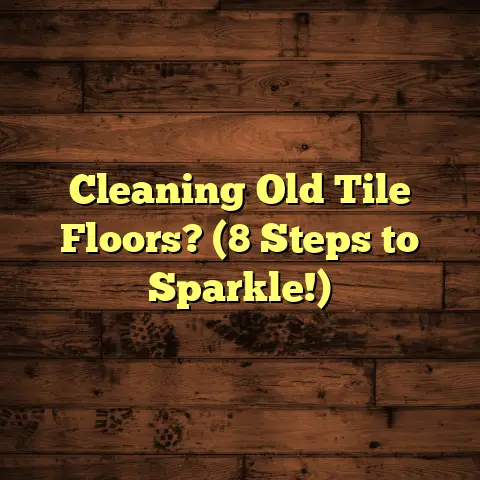Top Concrete Vapor Barriers? (1 Can Destroy!)
Trust me, I’ve seen it all – from beautiful hardwood floors buckling to tile installations that are more “crack-tastic” than fantastic. And more often than not, the culprit is moisture creeping up from the concrete slab.
That’s why choosing the right vapor barrier is crucial for protecting your investment and ensuring a long-lasting, beautiful floor.
But here’s the thing: it’s not just about the specs and numbers. Ease of use is a huge factor. A vapor barrier that’s a nightmare to install is more likely to be installed incorrectly, which defeats the whole purpose.
So, let’s get into it! I’ll walk you through what vapor barriers are, what to look for, some top contenders, and, yes, even the one you should avoid like the plague.
Section 1: Understanding Concrete Vapor Barriers
Okay, first things first: what is a concrete vapor barrier?
Simply put, it’s a material designed to prevent moisture from migrating through a concrete slab and into your flooring. Think of it as a raincoat for your floor.
Why is this so important?
Concrete, while seemingly solid, is actually porous. It absorbs moisture from the ground like a sponge.
This moisture vapor then travels upwards, potentially causing:
-
Mold and mildew growth: Nobody wants a funky-smelling or unhealthy home.
-
Adhesive failure: Moisture can weaken the bond between your flooring and the concrete, leading to loose tiles, bubbling laminate, or warping hardwood.
-
Structural damage: In extreme cases, excessive moisture can even contribute to the deterioration of the concrete itself.
I’ve seen moisture issues ruin brand new flooring installations. Trust me, it’s a costly and heartbreaking experience.
Where are vapor barriers used?
Everywhere! You’ll find them in:
- Residential basements: Below-grade slabs are particularly vulnerable to moisture.
- Slab-on-grade homes: Any home built directly on a concrete slab needs a vapor barrier.
- Commercial buildings: Offices, retail spaces, and warehouses all benefit from moisture protection.
Basically, if you’re installing flooring over concrete, you need to think about a vapor barrier.
Section 2: Key Features of Effective Vapor Barriers
So, what makes a good vapor barrier? Here are the key features I always look for:
-
Thickness: Measured in mils (thousandths of an inch), thickness generally equates to greater durability and moisture resistance. I usually recommend at least 10 mil for most residential applications.
-
Permeability Rating: This measures how much moisture can pass through the material. Lower is better! Look for a permeance rating of 0.1 perms or less, as per ASTM E96. Perms are a unit of measurement for water vapor permeability.
-
Material Composition: Polyethylene (PE) and Polyolefin are common materials. Polyolefin tends to be more durable and resistant to punctures. Recycled content is a plus for sustainability!
-
Puncture Resistance: This is crucial! A vapor barrier with low puncture resistance can be easily damaged during installation, creating weak spots for moisture to penetrate.
-
Compatibility: Make sure the vapor barrier is compatible with your chosen flooring material and adhesive. Some adhesives can react negatively with certain vapor barrier materials.
Let’s talk about compatibility a bit more.
Hardwood floors require a vapor barrier that allows for some breathability, preventing moisture buildup under the wood.
Tile and stone installations need a barrier that can withstand the alkalinity of the mortar.
Laminate and vinyl flooring are generally less sensitive, but a good vapor barrier is still essential for preventing mold and mildew.
Always check the manufacturer’s recommendations for both the flooring and the vapor barrier to ensure compatibility.
Section 3: Top Concrete Vapor Barriers on the Market
Alright, let’s get down to brass tacks. Here are some of the top concrete vapor barriers I’ve worked with and can recommend, focusing on ease of installation:
-
Stego Wrap Vapor Barrier: This is a popular choice among professionals. It’s a polyolefin-based barrier known for its durability and low permeability. It’s available in various thicknesses, with the 15-mil being a common choice.
-
Ease of Installation: Stego Wrap is relatively easy to handle due to its flexibility. It comes in large rolls, which can speed up installation in larger areas. Seams need to be properly taped with Stego Tape for a complete seal.
-
User Review: I’ve used this on several jobs and the contractors I work with appreciate the durability and the clear markings for overlap. One contractor told me, “It’s tough stuff, doesn’t tear easily, and gives me peace of mind.”
-
-
Raven Engineered Films VaporBlock Plus: Another high-performance polyolefin barrier with excellent puncture resistance. It’s designed for demanding applications where moisture control is critical.
-
Ease of Installation: VaporBlock Plus is available in large rolls and is relatively lightweight, making it manageable for installation. It’s also easy to cut and conform to irregular shapes.
-
User Review: A home builder I know swears by this stuff. He said, “I’ve used VaporBlock Plus on several high-end homes and never had a moisture issue. It’s a bit more expensive, but the peace of mind is worth it.”
-
-
Visqueen Polyethylene Sheeting: A more budget-friendly option, Visqueen is a polyethylene film that can be used as a vapor barrier. While not as durable as polyolefin barriers, it can be effective if properly installed.
-
Ease of Installation: Visqueen is lightweight and easy to cut, making it a popular choice for DIYers. However, it’s also more prone to tearing, so extra care is needed during installation.
-
User Review: I’ve used Visqueen on smaller projects where the budget was tight. One homeowner told me, “It was easy to install myself, but I was worried about tearing it. I ended up using two layers for extra protection.”
-
These are just a few examples, and there are many other excellent vapor barriers on the market.
Here’s a tip: Always check the manufacturer’s website for installation instructions and technical data sheets.
Section 4: The One Vapor Barrier That Can Destroy Your Project
Okay, folks, it’s time for the cautionary tale. There’s one type of “vapor barrier” that I absolutely cannot recommend:
6-mil Polyethylene Sheeting (Construction Film)
Yes, you read that right. That thin, flimsy plastic sheeting you see at the hardware store is not a suitable vapor barrier for flooring applications.
Why is it so bad?
-
Low Puncture Resistance: It tears easily, creating holes and compromising its ability to block moisture. I’ve seen contractors rip it just by walking on it!
-
High Permeability: It doesn’t effectively block moisture vapor. It’s simply too thin and porous.
-
Unreliable Seams: Taping seams is difficult, and the tape often fails over time, creating gaps for moisture to enter.
I’ve seen countless projects ruined by using 6-mil poly as a vapor barrier.
Here’s a real-life example:
I was called to a home where the brand-new hardwood floors were buckling and cupping. The homeowner had used 6-mil poly under the flooring, thinking it would save money.
The moisture vapor had penetrated the thin plastic, causing the wood to absorb moisture and warp. The entire floor had to be replaced, costing the homeowner thousands of dollars.
Don’t make the same mistake!
Using 6-mil poly as a vapor barrier is a false economy. It’s better to invest in a quality product that will actually protect your flooring and prevent costly repairs down the road.
Section 5: Comparison of Top Products
To help you make an informed decision, here’s a comparison chart of the top vapor barriers we discussed:
| Feature | Stego Wrap | VaporBlock Plus | Visqueen Polyethylene | 6-mil Polyethylene |
|---|---|---|---|---|
| Material | Polyolefin | Polyolefin | Polyethylene | Polyethylene |
| Thickness | 10-15 mil | 10-15 mil | Varies | 6 mil |
| Permeability | <0.1 perms | <0.1 perms | Varies | High |
| Puncture Resistance | Excellent | Excellent | Fair | Poor |
| Ease of Install | Good | Good | Very Good | Very Good |
| Cost | Higher | Higher | Moderate | Low |
| Best For | High-moisture areas | Critical apps | Budget-conscious | AVOID! |
Which product is right for you?
-
For high-moisture environments like basements or crawl spaces, Stego Wrap or VaporBlock Plus are excellent choices. Their low permeability and high puncture resistance will provide superior protection.
-
If you’re on a tight budget, Visqueen can be a viable option, but be sure to install it carefully and use multiple layers for added protection.
-
And remember, avoid 6-mil polyethylene sheeting at all costs!
Section 6: Conclusion
Choosing the right concrete vapor barrier is a critical step in any flooring project. It’s not just about preventing moisture; it’s about protecting your investment, ensuring the longevity of your flooring, and creating a healthy and comfortable living environment.
And remember, ease of use is key. A vapor barrier that’s easy to install is more likely to be installed correctly, maximizing its effectiveness.
Don’t cut corners on this important step. Do your research, choose a quality product, and follow the manufacturer’s instructions carefully.
Call to Action:
I’d love to hear about your experiences with concrete vapor barriers. What products have you used, and what were your results?
If you’re still unsure about which vapor barrier is right for your project, don’t hesitate to seek professional advice. A qualified flooring contractor can assess your specific needs and recommend the best solution for your situation.
Happy flooring! And remember, a little prevention goes a long way.





